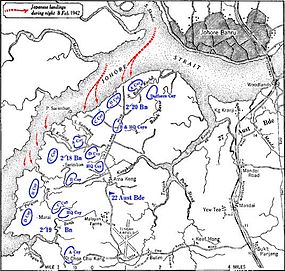用户:A22234798/莎琳汶沙滩战斗
| 莎琳汶沙滩战斗 | |||||||
|---|---|---|---|---|---|---|---|
| 太平洋战争中的新加坡战役的一部分 | |||||||
 1942年2月8早上十点时,盟军在莎琳汶区域的部署位置。图中的箭头显示日军的攻击方向。 | |||||||
| |||||||
| 参战方 | |||||||
|
|
| ||||||
| 指挥官与领导者 | |||||||
|
|
| ||||||
| 兵力 | |||||||
| ~3,000 | ~10,000 | ||||||
莎琳汶沙滩战斗是二战期间日本入侵新加坡的第一阶段,发生于1942年2月。莎琳汶位于新加坡岛的西侧,是山下奉文中将率领的日军发起对盟军的第一波攻势之处。新加坡守军指挥官亚瑟·帕西瓦尔并未预期到日军会在西侧发起主力攻势,因而未能增援首当其冲的澳大利亚第二十二旅。日军从此处登陆的主要目标是莎琳汶后方的登加机场。
背景
[编辑]在日军入侵以前,帕西瓦尔从澳大利亚第八师调拨两个旅给戈登·班奈特少将,以让他能负责防卫岛的西北区域。The terrain was primarily mangrove swamp and tropical forest, broken up by rivers and creeks. Brigadier Harold Taylor's 22nd Infantry Brigade, augmented by most of the Australian 2/4th Machine Gun Battalion, was assigned a 10 mile (16 kilometre) wide sector centred on Sarimbun Beach. The Jind Infantry Battalion of the Indian States Forces, which was guarding Tengah, and a company from Dalforce, a guerilla militia recruited from Singaporean Chinese. The 27th Infantry Brigade was assigned an adjoining 4,000 yard (3,650m) wide zone to the north, adjoining the causeway. The Australian 2/4th Machine Gun Battalion was distributed among the infantry units.
战斗
[编辑]At 8.30pm on 8 February, Australian machine gunners opened fire on vessels carrying a first wave of 4,000 troops from the 5th and 18th Divisions towards Singapore island. The Japanese assaulted Sarimbun Beach, which was held by the 22nd Brigade.
Fierce fighting raged all day but eventually the increasing Japanese numbers — as well as their superiority in artillery, planes and military intelligence — began to take their toll. The Japanese exploited gaps in the thinly-spread Allied lines such as rivers and creeks. By midnight, the two Australian brigades had lost communications with each other and the 22nd Brigade was forced to retreat. At 1am, further Japanese troops were landed and the last Australian reserves went in.
Towards dawn on 9 February, some elements of the 22nd Brigade had been overrun or surrounded, and the 2/18th Australian Infantry Battalion, in the centre, had lost more than half of its personnel. The 2/20th Australian Infantry Battalion, on the right flank was also heavily committed. At the same time, the 2/19th Australian Infantry Battalion, on the left, was being outflanked, and only "B" Company faced the initial landings by the Japanese.
Percival maintained a belief that further landings would occur in the northeast and did not agree to reinforce the 22nd Brigade until Tengah Airfield itself was threatened. However, before limited British and Indian infantry reinforcements arrived, the badly-battered Australian and Singaporean units, along with the Jinds, had retreated to take up positions on the "Jurong Line", stretching south from the village of Bulim. Tengah Airfield was taken by the Japanese at around midday on 9 February.
后续发展
[编辑]Shortly after dark on 9 February, three British Fairmile B motor launches were sent on a raid up the western channel of the Straits of Johor, adjoining Sarimbun Beach. Their objective was to attack Japanese landing craft and communications. They came under fire from enemy forces on both shores, but pressed on almost as far as the causeway. A few Japanese landing craft were sunk before the launches returned down the channel, reaching Singapore safely and suffering minimal damage. Some Allied soldiers saw this as an example of effective defensive tactics that were used too little and/or too late by their senior commanders.
参见
[编辑]参考
[编辑]- Lionel Wigmore, 1957, Australia in the War of 1939–1945, Volume IV — The Japanese Thrust, (1st ed.; Australian War Memorial: Canberra).
- Frank Owen, 2001, The Fall of Singapore, Penguin Books, ISBN 0-14-139133-2
外部链接
[编辑]- Wigmore, 1957, Australia in the War of 1939–1945, Volume IV — The Japanese Thrust, "Chapter 15 — Defence of Western Area" (1st ed.; Australian War Memorial, Canberra)
- Germaine Foo-Tan, 2004, "1942 — Sarimbun Beach Battle" (Singapore Ministry of Defence).
